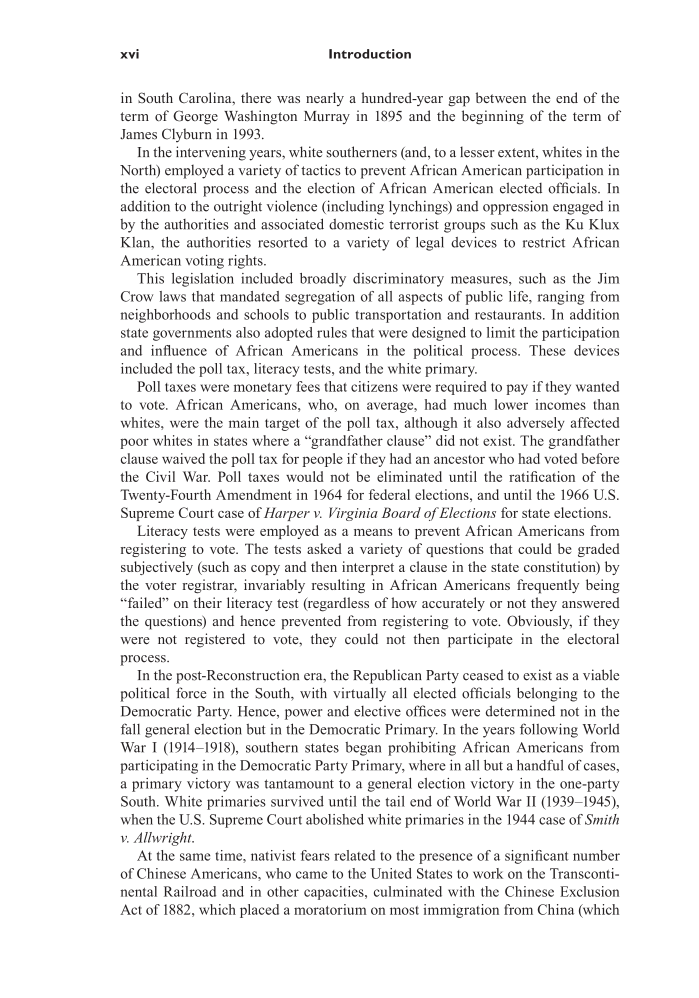xvi Introduction in South Carolina, there was nearly a hundred-year gap between the end of the term of George Washington Murray in 1895 and the beginning of the term of James Clyburn in 1993. In the intervening years, white southerners (and, to a lesser extent, whites in the North) employed a variety of tactics to prevent African American participation in the electoral process and the election of African American elected officials. In addition to the outright violence (including lynchings) and oppression engaged in by the authorities and associated domestic terrorist groups such as the Ku Klux Klan, the authorities resorted to a variety of legal devices to restrict African American voting rights. This legislation included broadly discriminatory measures, such as the Jim Crow laws that mandated segregation of all aspects of public life, ranging from neighborhoods and schools to public transportation and restaurants. In addition state governments also adopted rules that were designed to limit the participation and influence of African Americans in the political process. These devices included the poll tax, literacy tests, and the white primary. Poll taxes were monetary fees that citizens were required to pay if they wanted to vote. African Americans, who, on average, had much lower incomes than whites, were the main target of the poll tax, although it also adversely affected poor whites in states where a “grandfather clause” did not exist. The grandfather clause waived the poll tax for people if they had an ancestor who had voted before the Civil War. Poll taxes would not be eliminated until the ratification of the Twenty-Fourth Amendment in 1964 for federal elections, and until the 1966 U.S. Supreme Court case of Harper v. Virginia Board of Elections for state elections. Literacy tests were employed as a means to prevent African Americans from registering to vote. The tests asked a variety of questions that could be graded subjectively (such as copy and then interpret a clause in the state constitution) by the voter registrar, invariably resulting in African Americans frequently being “failed” on their literacy test (regardless of how accurately or not they answered the questions) and hence prevented from registering to vote. Obviously, if they were not registered to vote, they could not then participate in the electoral process. In the post-Reconstruction era, the Republican Party ceased to exist as a viable political force in the South, with virtually all elected officials belonging to the Democratic Party. Hence, power and elective offices were determined not in the fall general election but in the Democratic Primary. In the years following World War I (1914–1918), southern states began prohibiting African Americans from participating in the Democratic Party Primary, where in all but a handful of cases, a primary victory was tantamount to a general election victory in the one‑party South. White primaries survived until the tail end of World War II (1939–1945), when the U.S. Supreme Court abolished white primaries in the 1944 case of Smith v. Allwright. At the same time, nativist fears related to the presence of a significant number of Chinese Americans, who came to the United States to work on the Transconti- nental Railroad and in other capacities, culminated with the Chinese Exclusion Act of 1882, which placed a moratorium on most immigration from China (which
Document Details My Account Print multiple pages
Print
You have printed 0 times in the last 24 hours.
Your print count will reset on at .
You may print 0 more time(s) before then.
You may print a maximum of 0 pages at a time.



























































































































































































































































































































































































































































































































































































































































































































































































































































